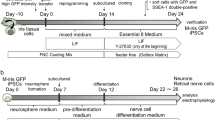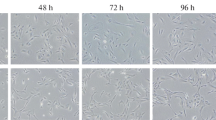Abstract
Iris epithelium is a double-layered pigmented cuboidal epithelium. According to the current model, the neural retina and the posterior iris pigment epithelium (IPE) are derived from the inner wall of the optic cup, while the retinal pigment epithelium (RPE) and the anterior IPE are derived from the outer wall of the optic cup during development. Our current study shows evidence, contradicting this model of fetal iris development. We demonstrate that human fetal iris expression patterns of Otx2 and Mitf transcription factors are similar, while the expressions of Otx2 and Sox2 are complementary. Furthermore, IPE and RPE exhibit identical morphologic development during the early embryonic period. Our results suggest that the outer layer of the optic cup forms two layers of the iris epithelium, and the posterior IPE is the inward-curling anterior rim of the outer layer of the optic cup. These findings provide a reasonable explanation of how IPE cells can be used as an appropriate substitute for RPE cells.






Similar content being viewed by others
References
Thumann, G. (2001). Development and cellular functions of the iris pigment epithelium. Survey of Ophthalmology, 45, 345–354.
Davis-Silberman, N., & Ashery-Padan, R. (2008). Iris development in vertebrates; genetic and molecular considerations. Brain Research, 1192, 17–28.
Moore, K. L. (1982). The developing human-clinical oriented embryology. Philadelphia: W.B. Saunders Company.
Larsen, W. J. (2002). Human embryology: health science Asia. Amsterdam: Elsevier Science.
Sweeney, L. J. (2003). Basic concepts in embryology. Beijing: Peking University Medical Press.
Sadler, T. W. (2004). Langman’s medical embryology. Baltimore: Lippincott Williams & Wilkins.
Dudek, R. W. (2011). Embryology. Baltimore: Lippincott Williams & Wilkins.
Bovolenta, P., Mallamaci, A., Briata, P., Corte, G., & Boncinelli, E. (1997). Implication of OTX2 in pigment epithelium determination and neural retina differentiation. Journal of Neuroscience, 17, 4243–4252.
Taranova, O. V., Magness, S. T., Fagan, B. M., Wu, Y. Q., Surzenko, N., Hutton, S. R., et al. (2006). SOX2 is a dose-dependent regulator of retinal neural progenitor competence. Genes & Development, 20, 1187–1202.
Beby, F., Housset, M., Fossat, N., Le Greneur, C., Flamant, F., Godement, P., et al. (2010). Otx2 gene deletion in adult mouse retina induces rapid RPE dystrophy and slow photoreceptor degeneration. PLoS ONE, 5, e11673.
Omori, Y., Katoh, K., Sato, S., Muranishi, Y., Chaya, T., Onishi, A., et al. (2011). Analysis of transcriptional regulatory pathways of photoreceptor genes by expression profiling of the Otx2-deficient retina. PLoS ONE, 6, e19685.
Matsushima, D., Heavner, W., & Pevny, L. H. (2011). Combinatorial regulation of optic cup progenitor cell fate by SOX2 and PAX6. Development, 138, 443–454.
Ma, W., Yan, R., Li, X., & Wang, S. (2009). Reprogramming retinal pigment epithelium to differentiate toward retinal neurons with Sox2. Stem Cells, 27, 1376–1387.
Tsukiji, N., Nishihara, D., Yajima, I., Takeda, K., Shibahara, S., & Yamamoto, H. (2009). Mitf functions as an in ovo regulator for cell differentiation and proliferation during development of the chick RPE. Development Biology, 326, 335–346.
Kim, J. S., Min, J., Recknagel, A. K., Riccio, M., & Butcher, J. T. (2011). Quantitative three-dimensional analysis of embryonic chick morphogenesis via microcomputed tomography. Anat Rec (Hoboken), 294, 1–10.
Roy, D., Steyer, G. J., Gargesha, M., Stone, M. E., & Wilson, D. L. (2009). 3D cryo-imaging: a very high-resolution view of the whole mouse. Anat Rec (Hoboken), 292, 342–351.
Takeda, K., Yokoyama, S., Yasumoto, K., Saito, H., Udono, T., Takahashi, K., et al. (2003). OTX2 regulates expression of DOPAchrome tautomerase in human retinal pigment epithelium. Biochemical and Biophysical Research Communications, 300, 908–914.
Martinez-Morales, J. R., Dolez, V., Rodrigo, I., Zaccarini, R., Leconte, L., Bovolenta, P., et al. (2003). OTX2 activates the molecular network underlying retina pigment epithelium differentiation. Journal of Biological Chemistry, 278, 21721–21731.
Sakami, S., Hisatomi, O., Sakakibara, S., Liu, J., Reh, T. A., & Tokunaga, F. (2005). Downregulation of Otx2 in the dedifferentiated RPE cells of regenerating newt retina. Brain Research. Developmental Brain Research, 155, 49–59.
Westenskow, P., Piccolo, S., & Fuhrmann, S. (2009). Beta-catenin controls differentiation of the retinal pigment epithelium in the mouse optic cup by regulating Mitf and Otx2 expression. Development, 136, 2505–2510.
Larsen, K. B., Lutterodt, M., Rath, M. F., & Moller, M. (2009). Expression of the homeobox genes PAX6, OTX2, and OTX1 in the early human fetal retina. International Journal of Developmental Neuroscience, 27, 485–492.
Uchikawa, M., Morishima, M., Saigou, Y., & Kondoh, H. (2010). The role of Sox2 in the regulation of eye development. Development Biology, 344, 484.
Westenskow, P. D., McKean, J. B., Kubo, F., Nakagawa, S., & Fuhrmann, S. (2010). Ectopic Mitf in the embryonic chick retina by co-transfection of beta-catenin and Otx2. Investigative Ophthalmology & Visual Science, 51, 5328–5335.
Masuda, T., & Esumi, N. (2010). SOX9, through Interaction with Microphthalmia-associated Transcription Factor (MITF) and OTX2, Regulates BEST1 Expression in the Retinal Pigment Epithelium. Journal of Biological Chemistry, 285, 26933–26944.
Kosaka, M., Kodama, R., & Eguchi, G. (1998). In vitro culture system for iris-pigmented epithelial cells for molecular analysis of transdifferentiation. Experimental Cell Research, 245, 245–251.
Albertine, K. H., & Dezawa, M. (2014). A new age of regenerative medicine: fusion of tissue engineering and stem cell research. Anat Rec (Hoboken), 297, 1–3.
Haruta, M., Kosaka, M., Kanegae, Y., Saito, I., Inoue, T., Kageyama, R., et al. (2001). Induction of photoreceptor-specific phenotypes in adult mammalian iris tissue. Nature Neuroscience, 4, 1163–1164.
Akagi, T., Mandai, M., Ooto, S., Hirami, Y., Osakada, F., Kageyama, R., et al. (2004). Otx2 homeobox gene induces photoreceptor-specific phenotypes in cells derived from adult iris and ciliary tissue. Investigative Ophthalmology & Visual Science, 45, 4570–4575.
Akagi, T., Akita, J., Haruta, M., Suzuki, T., Honda, Y., Inoue, T., et al. (2005). Iris-derived cells from adult rodents and primates adopt photoreceptor-specific phenotypes. Investigative Ophthalmology & Visual Science, 46, 3411–3419.
Thumann, G., Schraermeyer, U., Bartz-Schmidt, K. U., & Heimann, K. (1997). Descemet’s membrane as membranous support in RPE/IPE transplantation. Current Eye Research, 16, 1236–1238.
Yip, H. K. (2014). Retinal stem cells and regeneration of vision system. Anat Rec (Hoboken), 297, 137–160.
Acknowledgments
This study was supported by Ministry of Science and Technology, China (2006CB943700) and the National Natural Science Foundation of China (81170885). We thank the staff at the Institute of Stem Cell Research and Regenerative Medicine, Institutes of Biomedical Sciences of Fudan University.
Author information
Authors and Affiliations
Corresponding author
Electronic supplementary material
Below is the link to the electronic supplementary material.
12013_2014_310_MOESM1_ESM.tif
Fig. S1. Images of human fetus at different developmental stages. 5 w (A), 6 w (B), 7 w (C). (▲): Fetal human eye. (TIFF 2803 kb)
Rights and permissions
About this article
Cite this article
Wang, X., Xiong, K., Lu, L. et al. Developmental Origin of the Posterior Pigmented Epithelium of Iris. Cell Biochem Biophys 71, 1067–1076 (2015). https://doi.org/10.1007/s12013-014-0310-0
Published:
Issue Date:
DOI: https://doi.org/10.1007/s12013-014-0310-0




